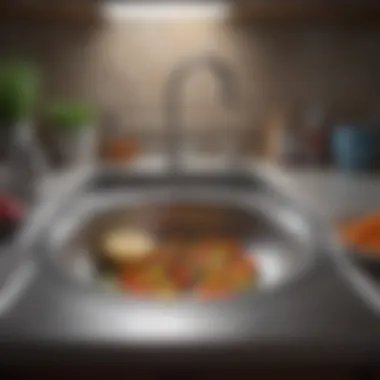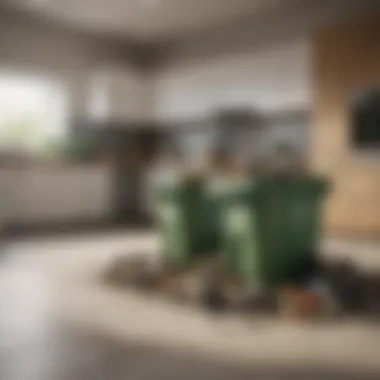Effective Solutions for Clogged Food Disposal Systems


Intro
Clogged food disposals can be an irritating challenge for homeowners. This issue often leads to significant inconveniences and potential plumbing problems. Understanding food disposal systems is crucial for anyone who wants to maintain a smoothly functioning kitchen. Over time, food disposal systems can become a breeding ground for clogs if not managed properly. This article delves into the causes of clogged disposals and offers effective methods to prevent and resolve these issues.
Managing food waste is not only important for home maintenance but also for environmental sustainability. Proper disposal practices can reduce the amount of waste that ends up in landfills. By addressing this topic thoroughly, readers gain valuable insights into effective food disposal systems.
Key Insights and Trends
Understanding the dynamics of modern kitchens can help homeowners prevent problems before they start. Not only have kitchen designs evolved, but so have disposal technologies. Some current trends include:
- Increased Use of Composting Systems: More homeowners are turning to composting as an alternative to disposals. Compost can enrich soil, and it cuts down on the garbage being sent to waste facilities.
- Smart Disposals: As part of the evolving technology, smart food disposals with sensors can detect clogs and alert users before serious issues arise.
- Sustainable Practices: Eco-friendly products and methods are taking center stage. Many homeowners are trying to adopt environmentally friendly practices in their kitchen management.
While these trends highlight innovations in kitchen practices, they also underline the importance of understanding how to integrate these solutions effectively.
Practical Tips and How-To Guides
Preventing Clogs: Regular maintenance is key to a functional disposal. Here are some practical tips:
- Run Cold Water: Always run cold water when using the disposal. This helps to solidify any grease, allowing it to be chopped up instead of clogging the pipes.
- Use the Disposal Regularly: Regular usage can prevent debris from building up and causing clogs.
- Avoid Certain Foods: Stay away from fibrous vegetables (like celery) and starchy foods (such as potatoes), as these can create blockages.
Unclogging a Disposal: If clogs do happen, here is a step-by-step guide:
- Turn Off the Power: For safety, unplug the disposal or turn off the circuit breaker.
- Check for Obstructions: Use a flashlight to look inside the disposal for any items causing the clog.
- Use a Plunger: If there is standing water, using a plunger may help to dislodge the blockage.
- Try a Homemade Remedy: A mixture of baking soda and vinegar can sometimes break down clogs when left for 15-30 minutes.
- Call a Professional: If all else fails, it is wise to consult a plumber.
"Preventive maintenance is always better than dealing with the consequences of neglect."
Overall, addressing food disposal clogs effectively not only streamlines kitchen operations but also contributes to broader environmental goals. Understanding best practices can make a difference in both household efficiency and sustainability.
Understanding Food Disposal Mechanisms
Understanding food disposal mechanisms is essential for maintaining a functional and efficient kitchen. These mechanisms are responsible for breaking down food waste and transporting it away from the sink. When properly understood, homeowners can prevent clogs, reduce kitchen odors, and promote better hygiene. The significance of this understanding lies in its impact on overall home maintenance and the environment.
Components of a Food Disposal System
A food disposal system typically consists of several key components:
- Grinding Chamber: This is where food waste is processed. It houses sharp blades that grind down materials into smaller particles.
- Motor: The motor powers the grinding chamber, allowing it to operate effectively. The strength of the motor can affect how quickly waste is processed.
- Discharge Tube: Once food waste is ground, the particles are pushed through this tube into the plumbing system, where they are carried away.
- Power Switch: This is usually found at the sink and controls the operation of the system.
- Reset Button: In case of overload, this button allows the motor to reset without needing professional assistance.
Each component plays a vital role in ensuring the smooth operation of the food disposal unit. Neglecting any part can lead to malfunctions such as clogging or inefficient waste processing.
How Food Waste is Processed
Food waste processing in a disposal system occurs in several stages:
- Ingestion: Food waste is fed into the disposal unit, either manually or through the sink.
- Grinding: As the motor activates, food particles are ground into small pieces. This is crucial for reducing the volume of waste and preventing pipes from clogging.
- Flushing: The small particles are then flushed through the discharge tube with the aid of water. This is where the role of kitchen plumbing comes into play, as the flow ensures that waste moves smoothly into the sewer system.
Understanding how food waste is processed helps homeowners optimize usage. For instance, using plenty of water while operating the disposal unit facilitates better movement of waste and reduces the risk of buildup.
"Proper knowledge of food disposal mechanisms can significantly minimize the chances of clogs and maintain kitchen hygiene."
For those interested in further insights, checking resources like Wikipedia may provide additional background on how these systems function.
Common Causes of Clogs
Understanding the common causes of clogs is essential for homeowners who rely on food disposal systems. Addressing these issues proactively can prevent significant problems and preserve the functionality of kitchen appliances. By recognizing the specific elements that lead to clogs, individuals can engage in effective maintenance practices and reduce the likelihood of inconveniences.


Inappropriate Items for Disposal
One of the primary reasons for clogging is the disposal of inappropriate items. Food disposals are designed to handle organic waste, but certain materials can lead to blockages. Common offenders include:
- Fibrous foods: Items like celery, corn husks, or artichoke leaves can wrap around the blades, preventing proper operation.
- Starchy foods: Ingredients such as pasta and rice expand when wet, creating a thick paste that can easily clog the disposal.
- Grease and fats: These substances can solidify and accumulate in pipes, leading to slow drainage and clogs.
It's important to develop a habit of avoiding the disposal of non-biodegradable items, such as plastics and metals. Developing an awareness of what is suitable for disposal can extend the lifespan of the appliance and maintain kitchen efficiency.
Build-Up Over Time
Another contributor to clogs is the gradual accumulation of waste over time. Even if a homeowner follows proper disposal routines, residues can build up in the pipes and disposal unit. Here’s how build-up starts:
- Insufficient flushing: If food waste is not adequately flushed with water, it can remain in the disposal and pipes, leading to a sticky residue.
- Lack of regular cleaning: Over time, even the most efficient disposal systems require cleaning. Neglect can lead to a buffering layer of waste that contributes to clogs.
Regular cleaning and flushing practices are essential to minimize build-up. Homeowners should consider using vinegar or baking soda to break down minor residues. This simple step can help prevent more serious complications.
Impact of Hard Water
The hardness of water varies widely across regions and can significantly influence the performance of food disposals. Hard water contains high levels of minerals such as calcium and magnesium, which can create mineral deposits. These deposits can lead to issues like:
- Reduced efficiency: Mineral build-up can obstruct moving parts within the disposal, making it less effective.
- Clogged pipes: Over time, build-up from hard water can contribute to a more significant clog in plumbing lines.
Installing a water softener can be a beneficial investment. It can help reduce mineral deposits, ensuring that the food disposal functions optimally and minimizing the risk of clogs. Regular maintenance checks to assess the effects of hard water on the disposal can be useful for long-term durability.
Proper understanding of clogging issues can lead to effective solutions and enhance the lifespan of kitchen appliances.
Identifying Signs of Clogging
Recognizing the signs of a clog in a food disposal system is a critical step in maintaining its functionality. Ignoring initial warning signs can lead to more severe plumbing issues and costly repairs down the line. Therefore, being attentive to these signs helps individuals proactively address potential problems, often before they escalate.
Slow Draining Waste
One of the primary indicators of a clog is when waste drains slowly. Typically, food disposals should clear waste efficiently. If users notice that water and food particles linger longer than normal, this sluggishness suggests that there may be something obstructing the drain. Factors contributing to slow drainage could include grease accumulation, fibrous materials, or even food particles wedged in the disposal unit or pipes.
To ensure effective operation:
- Regular Checks: Homeowners should periodically inspect the disposal, allowing them to spot any issues early.
- Routine Flushing: Running hot water while using the disposal can help dissolve grease that might be forming in the pipes.
Unpleasant Odors
Another sign of clogging comes in the form of foul smells emanating from the disposal. A properly functioning food disposal should not emit strong odors. If unpleasant scents arise, it typically means that food particles are trapped and decaying within the system. This not only indicates a clog but can also result in bacterial growth, which poses health risks.
To combat odors:
- Use Citrus: Grinding citrus peels can help freshen up the disposal.
- Regular Cleaning: Using baking soda and vinegar as a natural cleaning solution can eliminate residue that leads to odor formation.
Backflow Issues
Backflow occurs when water that should drain away instead flows back into the sink. This situation often indicates a more serious problem involving a significant clog or blockage in the pipes. Backflow can be particularly concerning since it might lead to dirty water and food waste entering living spaces, creating an unsanitary environment.
People should look for these signs:
- Water Gurgling: Noticeable gurgling sounds when the disposal is used can signal backpressure due to a clog.
- Pooling Water: If water starts to accumulate around the sink area, immediate attention is necessary.
Preventive Maintenance Practices
Preventive maintenance practices are vital to ensure the longevity and efficiency of food disposal systems in homes. Regular upkeep can significantly reduce the occurrence of clogs and malfunctions, saving homeowners both time and money. Taking proactive steps can protect plumbing systems from the common issues that arise from neglect.


Regular Cleaning Techniques
One of the foremost preventive maintenance activities involves regular cleaning of the food disposal unit. This task can be straightforward, yet it is often overlooked. Homeowners should use simple cleaning solutions that avoid harsh chemicals, which may damage the unit. Using a mixture of ice cubes and rock salt can help clean blades effectively. Running hot water combined with vinegar down the disposal not only eliminates odors but also helps clear minor blockages. Regular cleaning every few weeks prevents the buildup of debris and unpleasant smells, promoting smooth operation.
Proper Disposal Guidelines
Correct disposal practices are essential for preventing clogs. Homeowners must be informed about the types of food waste that can safely be processed by their disposal units. For instance, fibrous vegetables like celery, hard foods such as bones, and starchy items like potato peels can cause significant problems. It is advisable to cut large food items into smaller pieces to reduce strain on the system. Furthermore, avoiding pouring grease or fat down the disposal can prevent solidification and subsequent blockages.
Monitoring Usage Patterns
Awareness of usage patterns can inform better maintenance decisions. Homeowners should observe how often and what kinds of food waste are sent through the disposal. Keeping a log may provide insights into potential issues before they escalate. For instance, consistent slow drainage might indicate a developing blockage that can be addressed with preventive measures. Understanding average usage and recognizing deviations can facilitate timely interventions, prolonging the life of the disposal unit.
"Prevention is always better than cure. Being proactive can save significant costs in plumbing repairs and enhance the home’s efficiency."
These preventive maintenance practices not only secure the functionality of food disposals but also promote an environmentally friendly approach to waste management. There is a clear connection between effective usage and overall home sustainability. Practicing good habits in disposal maintenance sets homeowners on a path to a more seamless kitchen experience.
Immediate Responses to Clogging
The issue of food disposal clogging can disrupt daily routines within a household. Quick, effective responses are vital to manage any interference caused by these clogs. Addressing this problem in a timely manner can relieve potential plumbing complications and maintain the functionality of kitchen spaces. Knowing how to respond immediately can prevent minor issues from escalating into major headaches. Therefore, understanding the necessary steps to tackle clogs is essential.
Manual Inspection
One of the first steps when confronting a clogged disposal system involves a manual inspection. This practice allows homeowners to ascertain the specifics of the problem without dismissing any potential underlying issues.
Firstly, ensure that the disposal unit is turned off before beginning the inspection. This prevents any accidental operation during the process. After that, check the disposal opening for any visible obstructions. This could range from food remnants to foreign objects that should not be present. Use a flashlight if necessary to illuminate the area, making it easier to accurately assess the blockage.
Next, consider the condition of the disposal blades. Sometimes, the blades can become jammed due to hard food particles or other materials that are not suitable for disposal. If these are damaged or rusted, the unit will need repair or replacement. Here are some considerations to keep in mind during manual inspection:
- Avoid placing hands directly into the disposal. This can be dangerous, and using tools can offer a safer alternative.
- Identify recurring patterns. If certain items consistently cause clogs, modifying disposal habits may be needed.
By meticulously examining the system, homeowners can devise a plan of action tailored to their needs.
Common DIY Solutions
For those who find themselves facing a food disposal clog, common DIY solutions can often be beneficial. Addressing clogs without professional help not only saves money but also empowers homeowners to resolve future issues independently. Each of the following solutions can be effective if implemented properly:
- Plunge the Disposal: Using a plunger designed for kitchen sinks can often dislodge obstructions. Create a seal with the plunger over the drain, then apply a few strong thrusts.
- Use Baking Soda and Vinegar: Pour half a cup of baking soda followed by half a cup of vinegar into the disposal. The chemical reaction can help to break down clogs. Allow it to sit for around 15 minutes before rinsing with hot water.
- Flush with Hot Water: Periodically running hot water through the disposal can help dissolve grease and food particles, promoting a smooth and unclogged flow.
- Check the Trap: If more severe clogs persist, inspecting the u-joint trap under the sink may reveal additional blockages. Cleaning this area could solve ongoing issues.
"Immediate responses to food disposal clogs can minimize inconvenience and enhance kitchen efficiency."
These solutions are approachable for most homeowners and serve as a practical means to manage clogs effectively. Regularly utilizing these techniques can also promote longevity and efficiency of food disposal systems. Taking these simple steps can significantly ease the frustration of clogged disposals.
Professional Intervention
When experiencing persistent issues with food disposal, seeking professional intervention becomes crucial. Employing the expertise of a licensed plumber can prevent further complications and lasting damage to your plumbing system. Professional help offers many benefits, including a thorough diagnosis of the issue, access to specialized tools, and extensive knowledge of various waste disposal systems.
Understanding when to seek professional intervention is essential. Many homeowners attempt DIY solutions first, which can be effective for minor clogs. However, misdiagnosing the problem could lead to ineffective treatments that only aggravate the situation. This is where the decision to call in a professional can save both time and resources.
A professional will systematically evaluate the disposal unit and connected pipes, identifying clogs or other issues that are not visible to the untrained eye. Their recommendations can include immediate fixes and preventative strategies to avoid future occurrences.
The expertise a plumber brings can make the difference between quick resolution and prolonged distress in the kitchen.
When to Call a Plumber
Several signs indicate when it is necessary to contact a professional. If attempts to clear a clog with standard methods fail, or if you notice repeated blockages, it is advisable to call a plumber. Additional factors include:


- Severe Backflow: If waste begins to back up into the sink or dishwasher, this is a clear sign of a significant issue.
- Unusual Sounds: Strange noises coming from the disposal unit may indicate mechanical failure.
- Signs of Leaks: Puddles or wet areas around the disposal suggest potential leaks that could worsen.
By not addressing these signs promptly, homeowners risk more severe plumbing issues down the road.
Potential Maintenance Services Available
In addition to plumbing services, various maintenance solutions can assist homeowners in managing food disposal systems effectively. These may include:
- Annual Inspections: Regular check-ups can identify problems before they escalate.
- Cleaning Services: Cleaning the disposal unit and pipes helps maintain efficiency and longevity.
- Chemical Treatments: Professional-grade cleaning solutions can remove build-up more effectively than household products.
Investing in these services contributes to the overall health of the plumbing system and can lead to more sustainable usage of food disposal units. Homeowners should inquire about maintenance contracts or plans offered by local services for ongoing support.
Environmental Considerations
Understanding environmental considerations related to food disposal is crucial. This section emphasizes not only the ecological impact of waste management practices but also their long-term benefits. Food waste contributes to significant methane emissions when it ends up in landfills. Methane is a potent greenhouse gas, so addressing this issue is not just about convenience, but also about the health of our planet.
Effective disposal methods can rehabilitate food waste into valuable resources. Implementing proper strategies also benefits homeowners by improving waste management in a manageable manner. It aids in aligning household practices with sustainability goals. Enhancing awareness around environmental implications can transform how we view food disposal from being a nuisance to an essential part of our ecosystem.
Effective disposal practices can significantly reduce the environmental impact of food waste, making us better stewards of our planet.
Sustainability Through Effective Disposal
Sustainable food disposal is about reducing waste while maximizing resource recovery. Using disposers correctly is key. When homeowners use food disposers properly, their systems can redirect organic waste to wastewater treatment facilities where it can be processed. This helps in generating energy or compost, thereby contributing positively to the environment.
Here are some important approaches to ensure sustainable disposal:
- Educate on Disposal Use: Knowing what can and cannot go into food disposers is crucial. Only organic waste should be processed. Items like large bones or certain hard vegetables can damage disposers.
- Avoiding Overloading: Too much waste at once can lead to clogs. Ensuring that the waste is fed slowly and in small portions can enhance system efficiency.
- Regular Maintenance: Keeping disposers clean and in good condition maximizes their lifespan and performance.
By following these techniques, homeowners can participate actively in sustainability efforts.
Composting as an Alternative
Composting represents a proactive approach to food waste management. Instead of relying solely on disposers or landfills, composting allows organic waste to transform naturally into nutrient-rich soil. This not only keeps the waste out of landfills but also contributes positively to gardens or landscaping.
Composting is suitable for a variety of food scraps, including:
- Fruit and vegetable peelings
- Coffee grounds and filters
- Eggshells
- Leaves and grass clippings
Homeowners can engage in this practice with relative ease. Compost bins can be as simple as a designated area in the garden or specific containers designed for this purpose. The benefits are numerous:
- Reduced waste in landfills: This directly contributes to lower methane emissions.
- Improved soil health: Compost enhances soil structure, nutrient content, and moisture retention.
- Cost-effective gardening: Reducing the need for store-bought fertilizers and soil amendments.
By incorporating composting as a regular practice, homeowners can significantly reduce their food waste footprint while simultaneously enriching their gardening experience.
Technological Innovations
Technological advancements have significantly altered the way we manage food disposal in our homes. The introduction of innovative systems and smart appliances is not just a convenience, but a necessity for maintaining efficient waste management practices. This section explores the implications and benefits of these technologies, highlighting how they can help mitigate food disposal clogs effectively.
Advanced Disposal Systems
Advanced disposal systems are characterized by their enhanced processing capabilities. Unlike traditional disposals, these systems often incorporate specialized grinding mechanisms that tackle a broader range of food waste with ease.
- They can process fibrous materials like celery or large quantities of food scraps without jamming.
- Features such as automatic reset functions help in preventing overloading.
- These units often include noise-reduction technology, producing less sound pollution during use.
Moreover, some models connect directly to home plumbing, diverting waste to a composting facility rather than a landfill, promoting sustainability. By embracing these systems, homeowners can minimize the risk of clogging while also aligning their waste management practices with modern ecological standards.
Smart Appliances for Home Management
Smart appliances have emerged as a game-changer in managing home waste disposal systems effectively. With the ability to connect to home networks, these devices provide users with detailed feedback on usage patterns and potential issues before they escalate into major problems.
- Many smart disposals are equipped with sensors that can detect and alert homeowners when foreign items are placed inside the unit.
- Some systems send notifications regarding maintenance needs, encouraging timely intervention to prevent clogs.
- Moreover, integration with home automation systems allows for the scheduling of cleaning cycles at times when the disposal is least used, further reducing the chance of clogs.
Utilizing smart appliances not only enhances operational efficiency but it also educates users about sustainable disposal practices.



